Abstract
The aim of this study is to research modern educational technology (MET) at Faculty of Education - Palacky University Olomouc, Pedagogical University Tyrol and Trunojoyo University in Madura Indonesia as well as previous experience of future teachers with MET studying at these faculties. The basic question is which representatives of MET are available to the future teachers during their studies, and which representatives of MET future teachers actually employ in their studies. The main research tool was an online questionnaire which was distributed to students of the three faculties. The questionnaire was distributed electronically to students’ email addresses, and to their FaceBook groups. The results of the research were subsequently recorded and evaluated based on respondents' answers. This article presents the results which were achieved via this research. Respondents from three different faculties responded that they define or classify MET as the basis for this concept while they only rarely have no idea about this term. At the same time, it has been discovered that there is a great deal of interest in a course (or a subject) that may focus on the use of MET in teaching.
Keywords: Modern educational technologyfuture teachersteacher trainingequipment
Introduction
It is a generally accepted idea that teaching should be illustrative (Komenský, 1958) in order to be engaging. In order to make e.g. natural phenomena, vast or (conversely) tiny structures, or events of human history (which is no longer present - it is not possible to study it “in real time”) available to their pupils, teachers use various teaching aids and one of the various groups of teaching aids might be educational technology (or modern educational technology) which teachers often learn how to use in their teacher training during their studies.
The primary motivation for this paper was to describe this field of educational reality as the authors of the present paper deal with the topic of educational technology in their project. This paper, however, deals not only with the educational technology used by the teachers as a teaching aid (e.g. the interactive board or an overhead projector). It also deals with the modern technology at schools in more general terms in order to find out which types of technology were (and are) available for future teachers at their former schools and at universities at which they are currently studying. This paper also compares this issue in three different countries (in the Czech Republic, Austria and Indonesia).
In the introduction, the authors strive to describe and delimit the field of educational technology (while it is necessary to briefly describe the term
Technology
The term
in a traditional sense – the term technology is used to mark various devices and facilities which make findings in the field of science benefit the mankind (Daneš, n.d.), i.e. certain means of human activity as well as a summary of procedures and ways of activities that are used in the production and employment of those means (Kropáč, n.d.) – i.e. the technology in a narrow and in a broad sense. A similar term is a term technique which is understood as a way, a procedure, or a performance of a certain activity in general, e.g. in artistic or sport-related fields (Vlková, n.d.) – e.g. artistic techniques, etc. In this sense, the Czech uses the same overall term – technika.
in a modern sense – technology is understood as all purposefully produced objects created via human activity (this is called technika in Czech) while the way of realization of the activity with objects themselves is called technologie in Czech (Serafín, 2009).
In order to make the text clearer and unambiguous, the authors chose to use the term
It is technology which supports the development of human societies all over the globe, the development of social, intellectual, and physical abilities of individuals while it also improves solving of many complex tasks, situations, and problems in human lives. It also serves in the field of education, hence composing the field of educational technology.
Educational technology
In English, the term
The concept of
Since the basic terminological field is defined, it is possible to approach the problem statement section which also deals with the institutions that were participating in our research.
Problem Statement
The main premise of the research and, therefore, of this paper is that Czech and foreign universities (more concretely at faculties, schools providing teacher training) are similarly equipped with modern educational technology while their various means are available for the students. The level of equipment of the institutions participating in the research was researched via a questionnaire (which is described in the following chapters) which was filled-in by the students of these institutions.
In order to ensure that the equipment of the universities does not differ too much and to have a piece of evidence available (to ensure that the students participating in the research are not deliberately not telling the truth about the real situation at their school), the authors asked teachers of the participating universities for photos of their computer classrooms. Therefore, it is possible to illustrate the situation of the equipment of universities via the following photos that were taken at schools (universities) whose students were participating in our research.
The first photos were taken at the home university of the authors – Palacký University Olomouc (the Czech Republic), more concretely at the Faculty of Education (see Figure
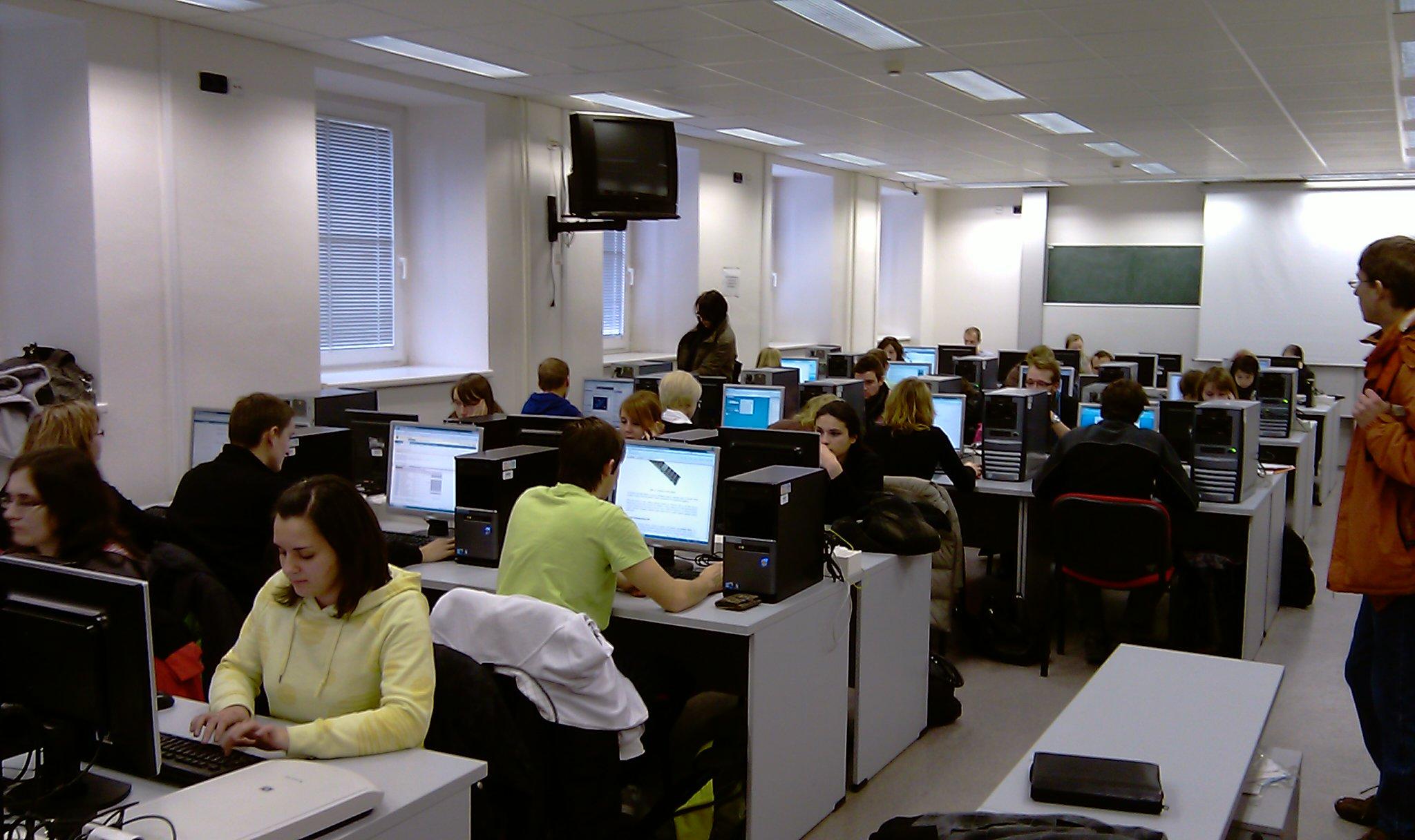
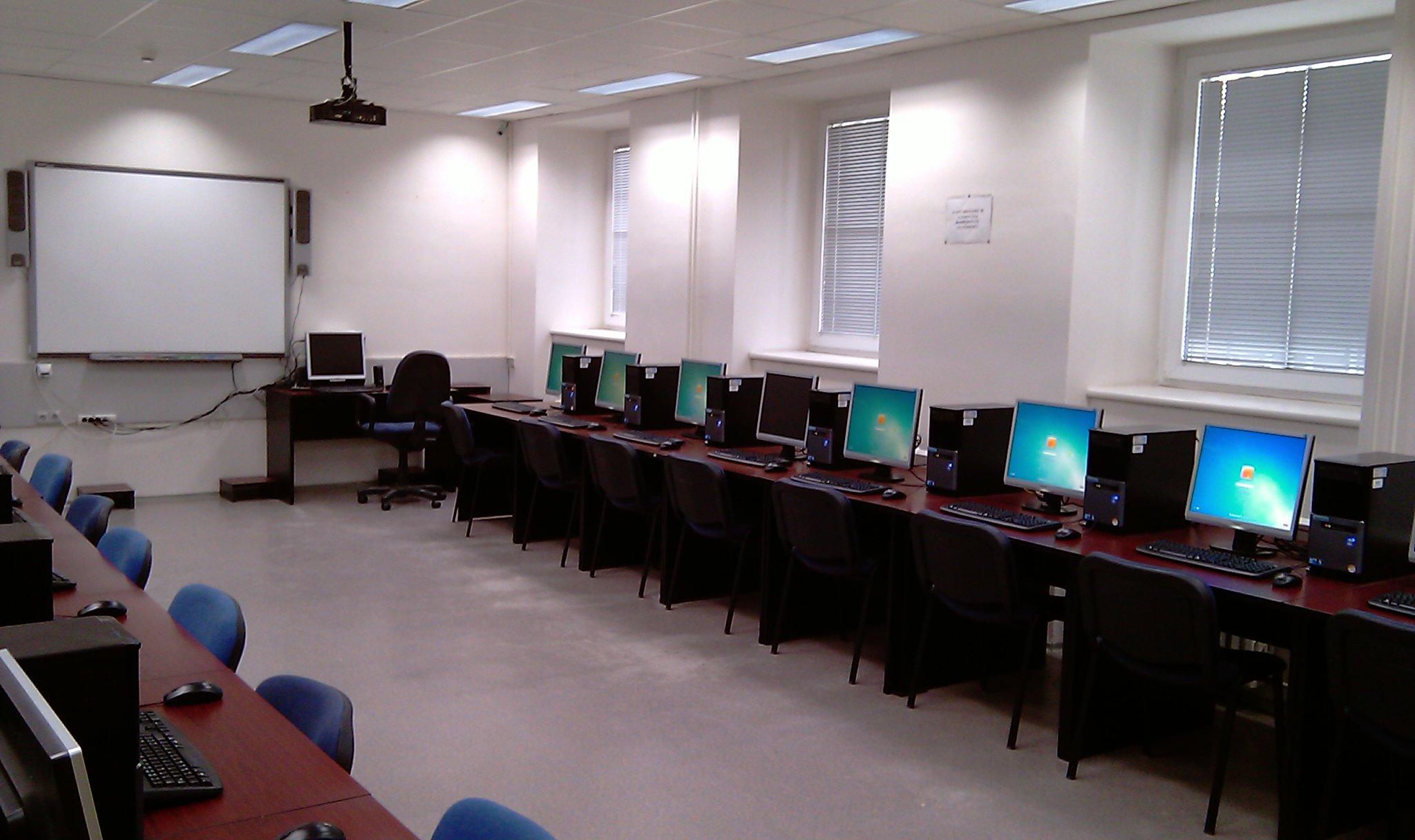
Figure
Figure
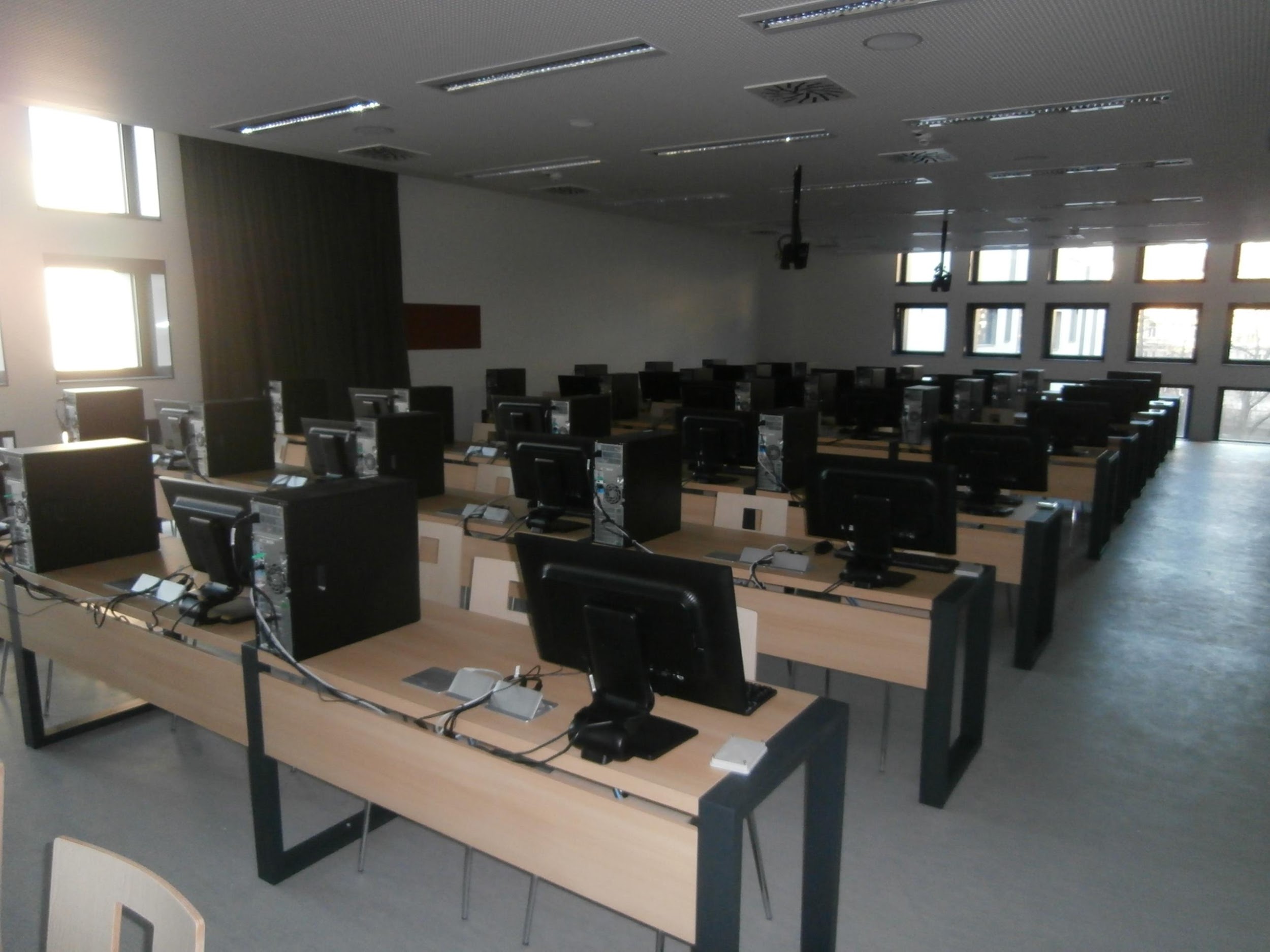
The second group of photos (Figure
On the other hand, Figure
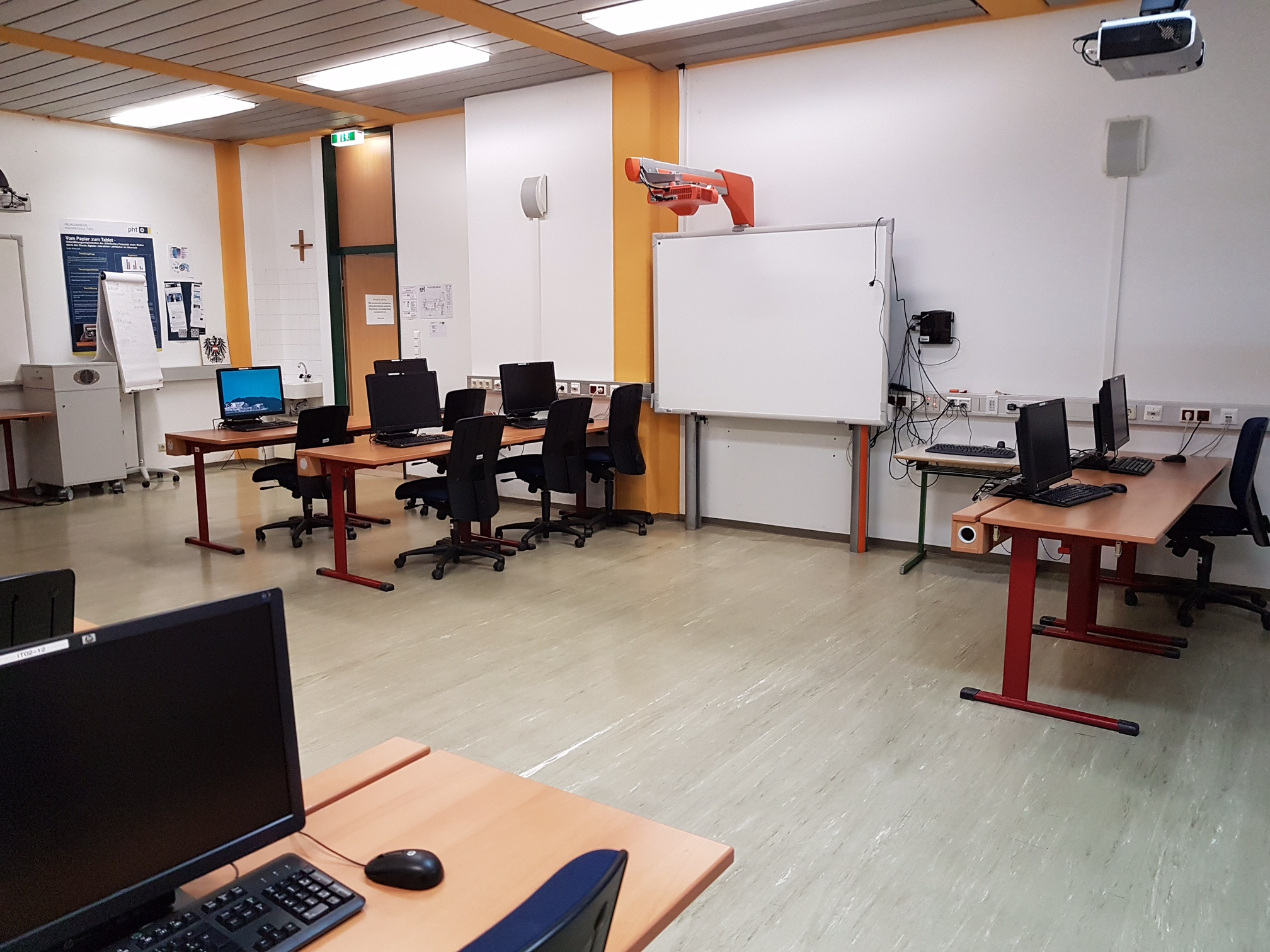
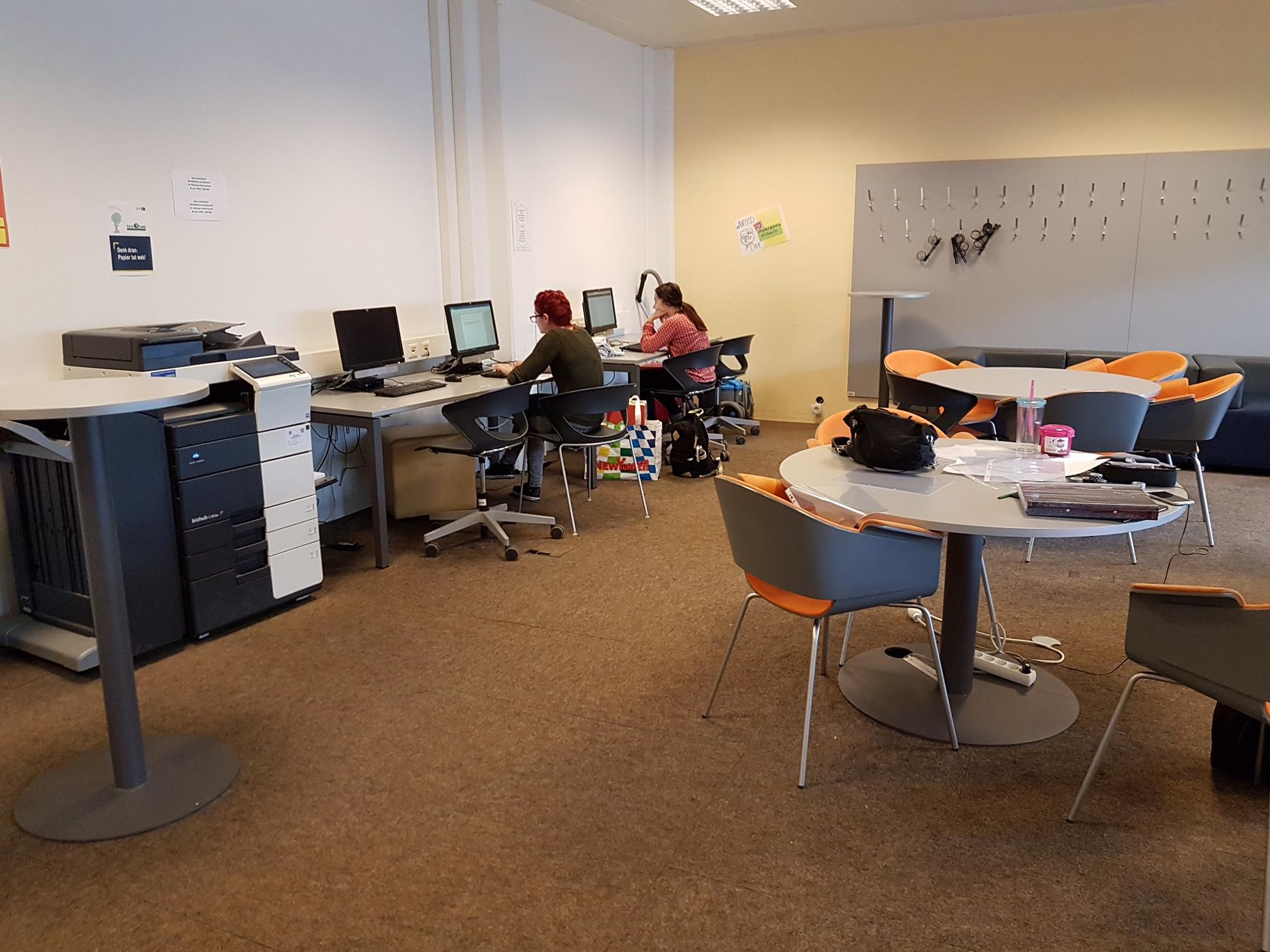
The last set of images – Figure
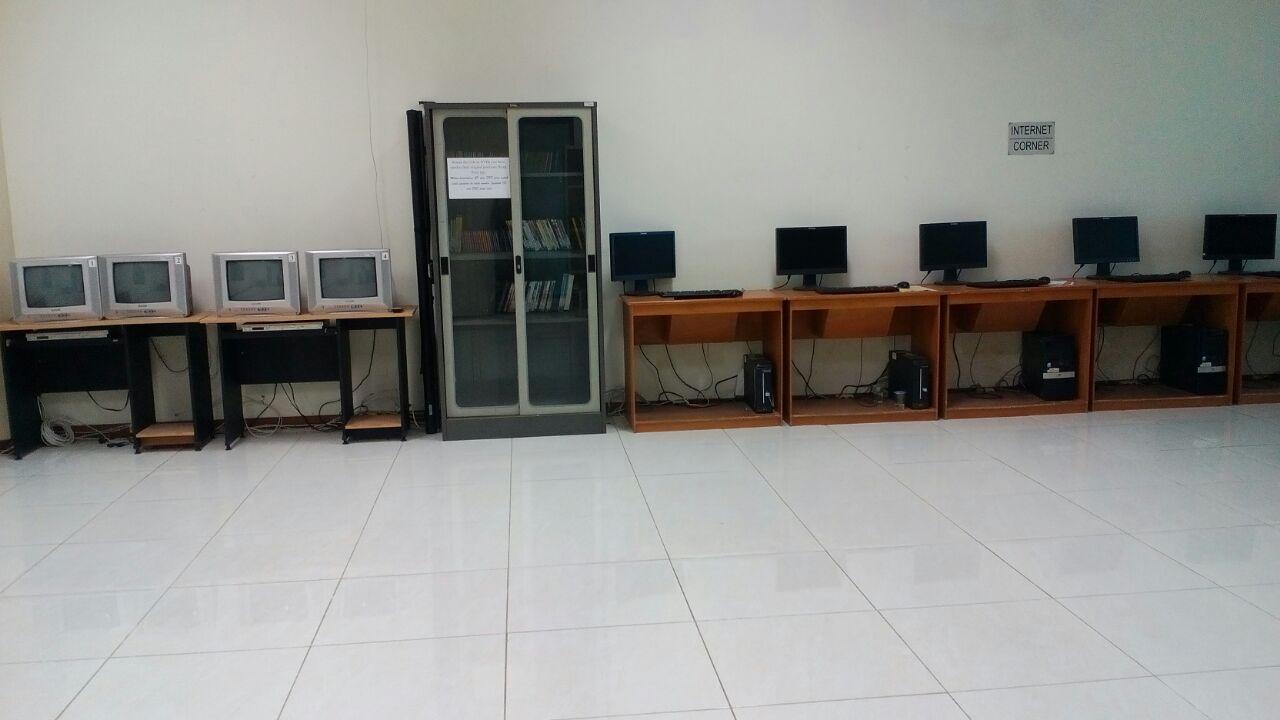
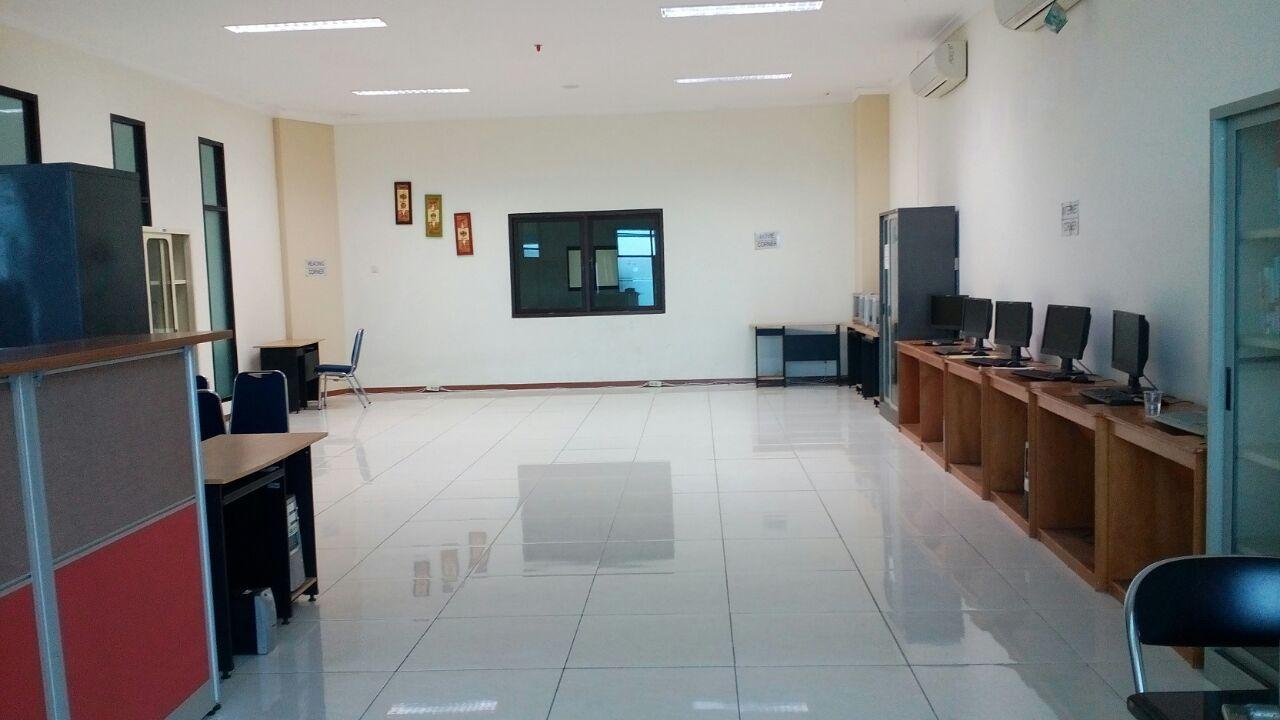
Despite this fact, future teachers in training tend to employ some of its representatives more frequently. The authors deal with this issue not only in terms of the mere equipment of the schools (which is dealt in the text of the present paper) but also in terms of teacher’s personality and their beliefs (which is to be addressed in the paper following on the present one, also based on the questionnaire presented here).
Since the authors successfully managed to proof that the institutions participating in the research are similarly equipped, it is possible to approach the empirical research itself – the research questions and the questionnaire itself.
Research Questions
The following research questions are dealt with in detail in the next sections:
What does the term modern educational technology mean to university students?
What representatives of MET do students have available at secondary schools? Which representatives of MET do students actually use in the course of their studies?
What representatives of MET do students have available at university? Which representatives of MET do students actually use in the course of their studies?
Would teacher trainees welcome a course focused on modern educational technology and its use for education?
What type of MET would students like to learn to work with?
Full version of the questionnaire available at: http://bit.ly/dotaznik-MDT (Czech version), http://bit.ly/questionnaire-MET (English version), http://bit.ly/fragebogen-MDT (German version).
Purpose of the Study
The study aims to depict the difference in employment of modern educational technology and frequency of its representation at Czech and foreign schools. It also addresses the issue of possible future university courses focusing on MET based on actual needs and wants of students in teacher training programmes.
Research Methods
The next part of the article describes the results of a research study based on a questionnaire that was distributed to students of the Faculty of Education UP, students of Pedagogical University Tyrol, and students of Trunojoyo University in Madura Indonesia. The questionnaire was distributed electronically via students’ university email addresses, or a social media site FaceBook while the site Google Forms (Get started with Forms, n.d.) was used. The aim of the questionnaire was to find out what these students know about modern educational technology, what they imagine hearing this term, what their experience is using this type of technology, and what relationship they have towards it in general. Data from the Czech Republic are then compared with data from foreign universities. Based on this comparison, the research questions were answered.
The research was being conducted during March and April 2017 and the questionnaire was completed by 110 students (to the date 2nd July 2017) from the Faculty of Education of Palacky University (onwards as PdF UP), by 21 students from Pedagogical University Tyrol (onwards as PHT), and 34 students from Trunojoyo University in Madura in Indonesia (onwards as UTMS). The questionnaire itself was divided into two sections, one with items of general nature and the second with questions focusing on the field being researched. There were seven general questions that were supposed to define the representative sample. The theory behind the research is described in a TVV article (Čihánková, Gregar, Sittová, 2017).
Findings
The research involved 110 respondents from the Czech Republic with 18 of them being male and 92 female. The respondents were of different ages but majority of them, one hundred, were younger than 26 years (older students were in long-distance programmes). Twenty-one respondents were from PHT with 18 female and 3 male respondents while most of these students were between ages 20 and 23 (more than 66 per cent). There were 14 female and 18 male students from the UTMS who completed the questionnaire and all of them were 21 years of age or younger. The largest age group was 19 years old or less (22 respondents).
Next question was focused on previous education of the respondents. In the Czech Republic, It was found that schools providing general education were represented the most with 69 per cent and the second most attended schools with 18 per cent were secondary schools specializing in education. The remaining percentage was divided into schools with different specializations (8 per cent) and university education (5 per cent). Almost half of the Czech students participating in the study are students of bachelor degree programmes (45.5 per cent); 24.5 per cent of students are part of continuing master's degree programmes and finally, 30 per cent of respondents are in masters degree programmes. Majority of respondents (55.5 per cent) are in their first year of studies and 26.4 per cent in their second. 27 respondents study education for primary teachers while the rest have different study combinations. A large representation of respondents is studying e.g. Czech language for education, or English language for education, or remedial pedagogy.
Seventy per cent of students from PHT studied at AHS (general college) or at BHS (specialized colleges). All the respondents are in their bachelor programmes while 10 are in their second year, 5 in their first, and 4 in their fourth year of studies. Seventeen students from Indonesia said that they had finished general education at secondary schools, 3 respondents attended specialized secondary schools and the rest of respondents claimed having finished various courses. All of these students are in their bachelor studies, with 42.4 per cent in the first year, 45.5 per cent in the second, and the rest in either their third or fourth year.
Questions of specialized nature followed with the aim of discovering future teachers’ awareness of modern educational technology and their relationship towards it. The last part of the questionnaire was designed as a table with statements in which respondents expressed their degree of agreement or disagreement with each statement.
First two items in the questionnaire were directed to find out what MET is according to the students and what it means to them. The method of unfinished sentences was used for this purpose. Focusing on the first part of the question, the majority of students at PdF UP tried to define modern educational technology either with the help of definitions and relations (64 respondents) or using concrete examples to explicitly show what MET is (22 respondents). Fourteen students expressed their opinion about MET but they did not give any definition, or examples. The remaining 10 students answered that they did not know what MET was. In most cases, students from PHT also tried to define the term (7 students), 4 students stated that they had never heard the term modern educational technology before and the rest did not offer any definition or examples of MET. Twenty-three students from UTMS wrote down a definition, other two even listed limits and advantages of MET and other two just wrote short sayings such as “computer skills” or “modern education”.
Second part of the mentioned question above asked students to write down what MET means to them. The majority of PdF UP students (71 of them) said that they see MET as a tool that could have a positive impact on lessons with the teacher using it to make the subject matter easier to understand and liven up lessons. Other 10 respondents once again described what MET means to them by listing its representatives, 15 students did not give any definition nor did they describe their relationship to MET but they did provide one-word responses, saying that MET means to them “a lot” or “a tool”. Five respondents expressed that MET means generally technical devices or tools for education but they did not provide examples. Eight students answered that they do not know what MET means to them, one student said it means nothing to him and another student answered that MET means “depersonification”. Modern educational technology was seen as a beneficial asset by 3 students of PHT, other 8 students once again wrote either a definition or examples of MET. The remaining students mentioned that MET means to them e.g.: “new methods”, “they are important”, or “pushing media into education”. All students from UTMS showed a positive attitude to modern educational technology. For 19 of them, MET means “help, making things easier, faster, or improvement of lessons, etc.” Two respondents saw it as another way of education and one even saw it as a future for education and life without paper and therefore, a way of improving environment. The rest of students answered similarly to students from the Czech Republic, saying that MET means “a lot” to them. There was a noted difference in the answers of Czech and Austrian students compared to Indonesian students in the way their answers in open questions were formulated. While Czech and Austrian students offered simple, short, often one-word answers, Indonesian students offered longer sentences that showed deeper reflection on the topic presented.
Third question delved into the past of the respondents, asking them what representatives of educational technology they had as students in their secondary schools. The question was designed as closed with the choice of 16 options from which students could choose more than one. Vast majority of Czech students, 106 respondents, disclosed that they had overhead projectors at their disposal, 87 students had interactive whiteboards and the same numbered had an access to a TV in their studies. Another frequently chosen means of technology were computers (76 resp.), reprographic tools (71), radio (69), or office suites (54). All students from PHT marked computer as representatives of MET which they had available during their studies, 18 marked radio, 16 television, and 13 marked video recorder. It can be noticed that 79 per cent of Czech students had interactive whiteboards while only 19 per cent of Austrian students had it available and just 30 per cent of students from Indonesia who marked computers as being available the most (24 respondents).
Item four in the questionnaire is connected to the previous one as it asks which educational technology students actually utilized during the course of their studies for educational purposes. Eighty Czech respondents chose the option of a computer and the same number used overhead projectors as well. Only 64 students used interactive whiteboards which means that even though 79.1 per cent of students had interactive whiteboards at their disposal in classes, only 58.2 per cent of students actually used them. The second group of respondents (PHT) listed the same representatives of MET as in the previous question, that is: computers (18), radio (11), and television (11). There was no significant difference in the third group either. The first place still belongs to computers (21 respondents), data projector (15), and reprographic tools (14).
Next queries about MET were the same as the previous two laid out questions with the difference that they focused on the present, that is the current condition during the student's’ studies at university. When asked what representatives of MET students have available at their university, almost every student of PdF UP chose an overhead projector, 83 respondents chose an interactive whiteboard, and a same number answered that they can use computer for their education at the university. The least chosen items were a software for teaching writing on a keyboard (3 respondents), and ebook readers (4 students). All Austrian students have computers at their disposal, 85.7 per cent have interactive whiteboards and 71.4 per cent have data projector. Indonesian students list computers (78.8 per cent), projector (75.8 per cent), and interactive whiteboard (60.6 per cent) as being available to them at their University. The same representatives of MET appear in all questioned groups.
For the following question about the actual utilization of MET, 74 Czech respondents answered that they use the projector, and 71 use a computer. Only 40 respondents stated that they use interactive whiteboard which indicates that even at universities interactive whiteboards are available for 75.5 per cent of students, but they are used only by 36.4 per cent of them. With the students from PHT, the biggest difference between MET being present and actually using it was with a data projector – 71.4 per cent of students have them at schools but only 38.1 per cent uses them in their studies. There was a drop in the numbers with Indonesian students as well but it was not as big – 60.6 per cent use data projector in their lesson even though it is available for 75.8 per cent of them.
Seventh item in the questionnaire asked students if they would be interested in a course or a subject that would be part of their pre gradual studies and that would focus on how to actually utilize MET in their teaching – 72 Czech students answered that they would be interested. Those then had the option to choose what kind of educational technology they would like to learn to work with and overall majority (37 of them) said that they would be interested in a course teaching using of interactive whiteboards. Other options like tablets, programming languages, or video were only chosen by a small number of students. Eighty-one per cent of Austrian students are interested in having a university course focused on MET while they would appreciate the most learning about using tablet (8 respondents) and interactive whiteboard (6 respondents) for education. Almost every Indonesian student would be interested in a course (94.1 per cent) with focus on mostly programming languages, office software and computers in general.
The last part of the questionnaire was based on scaling in which respondents were asked to express their degree of agreement with statements on a scale from “strongly agree” to “strongly disagree”. The aim of this part was to create an understanding about the relationship students have towards MET, but this part is not part of this article.
The biggest difference in the employment of MET was in terms of interactive white boards (IWB). They were available only for 24 per cent of foreign respondents at their secondary schools, contrarily to 79 per cent of Czech respondents. This might have also resulted in the expressed willingness of Czech respondents to learn how to use the IWB.
Conclusion
The results of this research might be influenced by different educational systems of participating countries. The tendency to employ and to equip schools with modern educational technology is present in all of them; however, in foreign countries, future teachers tend to employ more diverse means of MET compared to Czech schools which predominantly use interactive whiteboards. This is also the reason why Czech students are interested in having a course or subject at their university that would be focus on this topic. This study can be partially taken as a preliminary research to find what course students of PdF UP would welcome during their preparation to become teachers.
Acknowledgments
We thank doc. PhDr. Milan Klement, Ph.D. for his photos of ICT classrooms of the Faculty of Education, Palacky University Olomouc (Czech Republic), prof. Wolfgang Haupt for his photos of ICT classroom of Pädagogische Hochschule Tirol (Austria), and dr. Imron Wakhid Harits for his photos of ICT classroom of Universitas Trunojoyo Madura (Indonesia).
The article was created with a financial support of the project of Grant fund of the Dean of the Faculty of Education, Palacký University Olomouc, 2017 in the framework of the project “The Significant Educational Categories, Phenomena and Means in the Process of Shaping of Professional Teacher Beliefs” – IGA_PdF_2017_029.
References
- Association for Educational Communications and Technology (2008). Definition. In A. Januszewski and M. Molenda (Eds.), Educational Technology: A definition with commentary. New York: Lawrence Erlbaum Associates.
- Bildungstechnologie. (n.d.). Retrieved July 30, 2017, from http://www.dict.cc/german-english/Bildungstechnologie.html
- Daneš, F. (n.d.). Technologie versus technika. Retrieved April 06, 2017, from http://casopis.vesmir.cz/clanek/technologie-versus-technika
- Čihánková, H., Gregar, J., & Sittová, B. ((in print)). Subjektivní vnímání moderní didaktické techniky, přínosy a limity jejího využití v kognitivních strukturách studentů učitelství na PdF UP v Olomouci. Trendy ve vzdělávání.
- Get started with Forms – Google Learning Center. (n.d.). Retrieved July 30, 2017, from https://gsuite.google.com/learning-center/products/forms/get-started/
- Komenský, J. A. (1958). Velká didaktika. In Vybrané spisy Jana Ámose Komenského. Svazek I. Redakce Jan Patočka. Praha: SPN, pp. 41–281
- Komosný, J. (2013). Učební pomůcky a didaktická technika ve výuce odborných předmětů. Retrieved July 30, 2017, from https://is.muni.cz/th/209681/pedf_c/Zaverecna_Prace.pdf
- Kropáč, J. (n.d.). Odlišnosti a analogie mezi pedagogikou a technickými vědami z hlediska oborové didaktiky technických předmětů. Retrieved April 06, 2017, from http://epedagog.upol.cz/eped2.2002/clanek06.htm
- Kropáč, J (2004). Didaktika technických předmětů: vybrané kapitoly. 1st Ed. Olomouc, Univerzita Palackého.
- Maňák, J. (2003). Nárys didaktiky. Brno: Masarykova univerzita.
- Nosková, L. (2011). Využívání moderní didaktické techniky ve výuce odborných předmětů na SOŠ. Brno: MU.
- Palán, Z. (2002). Didaktické prostředky - didaktická technika. Retrieved April 06, 2017, from http://www.andromedia.cz/andragogicky-slovnik/didakticke-prostredky-didakticka-technika
- Rambousek, V. (2014). Materiální didaktické prostředky. V Praze: Univerzita Karlova, Pedagogická fakulta.
- Serafín, Č. (2009) Technické myšlení ve vztahu k výuce podporované a realizované elektrotechnickými stavebnicemi. In Journal of Technology and Information Education. 2009. Issue 1. Vol 2. Available at: http://jtie.upol.cz/09_2.htm. ISSN 1803-6805
- Vlková, V. (n.d.). Technika, či technologie? - Časopis Světlo - Odborné časopisy. Retrieved April 06, 2017, from http://www.odbornecasopisy.cz/svetlo/casopis/tema/technika-ci-technologie--16691.
Copyright information

This work is licensed under a Creative Commons Attribution-NonCommercial-NoDerivatives 4.0 International License.
About this article
Publication Date
16 October 2017
Article Doi
eBook ISBN
978-1-80296-030-3
Publisher
Future Academy
Volume
31
Print ISBN (optional)
-
Edition Number
1st Edition
Pages
1-1026
Subjects
Education, educational psychology, counselling psychology
Cite this article as:
Čihánková, H., Gregar, J., & Sittová, B. (2017). Czech And Foreign Schools And Their Employment Of Modern Educational Technologies. In Z. Bekirogullari, M. Y. Minas, & R. X. Thambusamy (Eds.), ICEEPSY 2017: Education and Educational Psychology, vol 31. European Proceedings of Social and Behavioural Sciences (pp. 366-379). Future Academy. https://doi.org/10.15405/epsbs.2017.10.34

